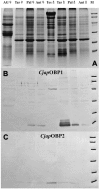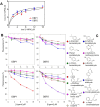Male tarsi specific odorant-binding proteins in the diving beetle Cybister japonicus sharp
- PMID: 27545810
- PMCID: PMC4992826
- DOI: 10.1038/srep31848
Male tarsi specific odorant-binding proteins in the diving beetle Cybister japonicus sharp
Abstract
Odorant binding proteins (OBPs) play critical roles in chemical communication of insects, as they recognize and transport environmental chemical signals to receptors. The diving beetle Cybister japonicus Sharp shows a remarkable sexual dimorphism. The foreleg tarsi of males are equipped with large suction cups, believed to help holding the female during underwater courtship and mating. Here, we identified two OBPs highly and specifically expressed in male tarsi, suggesting important functions of these structures in chemical communication. The first protein, CjapOBP1, exhibits the 6 conserved cysteines motif of classic OBPs, while the second, CjapOBP2, contains only four cysteines and can be assigned to the sub-class of C-minus OBPs. Both proteins were expressed in a bacterial system and the purified recombinant proteins were used to for antibodies preparation. Western Blot analysis showed that CjapOBP1 is predominantly expressed in male tarsi and could be also detected in antennae and palpi of both sexes, while CjapOBP2, besides male tarsi, is also present in testis. Ligand-binding experiments showed a good binding affinity between CjapOBP1, CjapOBP2 and citral and coniferyl aldehyde, respectively. These results support a possible function of these two OBPs in the male foreleg tarsi of diving beetles in chemical communication.
Figures





Similar articles
-
Tissue-specific transcriptomics, chromosomal localization, and phylogeny of chemosensory and odorant binding proteins from the red flour beetle Tribolium castaneum reveal subgroup specificities for olfaction or more general functions.BMC Genomics. 2014 Dec 18;15:1141. doi: 10.1186/1471-2164-15-1141. BMC Genomics. 2014. PMID: 25523483 Free PMC article.
-
Expression Profiles and Functional Characterization of Two Odorant-Binding Proteins From the Apple Buprestid Beetle Agrilus mali (Coleoptera: Buprestidae).J Econ Entomol. 2018 May 28;111(3):1420-1432. doi: 10.1093/jee/toy066. J Econ Entomol. 2018. PMID: 29590372
-
Odorant-Binding Proteins and Chemosensory Proteins from an Invasive Pest Lissorhoptrus oryzophilus (Coleoptera: Curculionidae).Environ Entomol. 2016 Oct;45(5):1276-1286. doi: 10.1093/ee/nvw111. Epub 2016 Aug 28. Environ Entomol. 2016. PMID: 27569597
-
The 40-Year Mystery of Insect Odorant-Binding Proteins.Biomolecules. 2021 Mar 30;11(4):509. doi: 10.3390/biom11040509. Biomolecules. 2021. PMID: 33808208 Free PMC article. Review.
-
Structural aspects of sexual attraction and chemical communication in insects.Trends Biochem Sci. 2004 May;29(5):257-64. doi: 10.1016/j.tibs.2004.03.003. Trends Biochem Sci. 2004. PMID: 15130562 Review.
Cited by
-
The antennal transcriptome analysis and characterizations of odorant-binding proteins in Megachile saussurei (Hymenoptera, Megachilidae).BMC Genomics. 2023 Dec 15;24(1):781. doi: 10.1186/s12864-023-09871-8. BMC Genomics. 2023. PMID: 38102559 Free PMC article.
-
Identification and comparative expression analysis of odorant-binding proteins in the reproductive system and antennae of Athetis dissimilis.Sci Rep. 2021 Jul 6;11(1):13941. doi: 10.1038/s41598-021-93423-1. Sci Rep. 2021. PMID: 34230568 Free PMC article.
-
Dynamic Roles of Insect Carboxyl/Cholinesterases in Chemical Adaptation.Insects. 2023 Feb 16;14(2):194. doi: 10.3390/insects14020194. Insects. 2023. PMID: 36835763 Free PMC article. Review.
-
Roles of insect odorant binding proteins in communication and xenobiotic adaptation.Front Insect Sci. 2023 Oct 6;3:1274197. doi: 10.3389/finsc.2023.1274197. eCollection 2023. Front Insect Sci. 2023. PMID: 38469469 Free PMC article. Review.
-
Diving beetle-like miniaturized plungers with reversible, rapid biofluid capturing for machine learning-based care of skin disease.Sci Adv. 2021 Jun 16;7(25):eabf5695. doi: 10.1126/sciadv.abf5695. Print 2021 Jun. Sci Adv. 2021. PMID: 34134988 Free PMC article.
References
-
- Clyne P. J. et al.. A novel family of divergent seven-transmembrane proteins: candidate odorant receptors in Drosophila. Neuron. 22, 327–338 (1999). - PubMed
-
- Vosshall L. B., Amrein H., Morozov P. S., Rzhetsky A. & Axel R. A spatial map of olfactory receptor expression in the Drosophila antenna. Cell. 96, 725–736 (1999). - PubMed
-
- Rytz R., Croset V. & Benton R. Ionotropic Receptors (IRs): Chemosensory ionotropic glutamate receptors in Drosophila and beyond. Insect Biochem Mol Biol. 43, 888–897 (2013). - PubMed
Publication types
MeSH terms
Substances
LinkOut - more resources
Full Text Sources
Other Literature Sources

